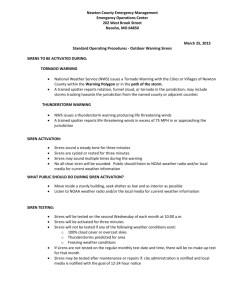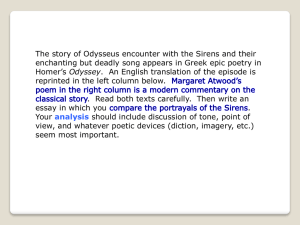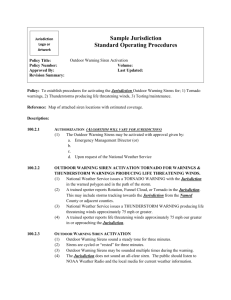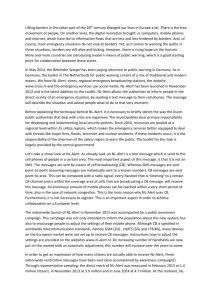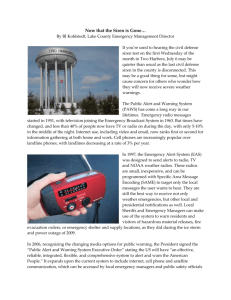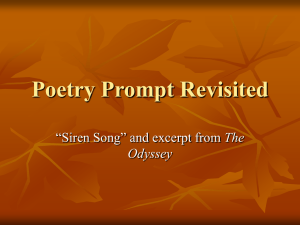KC Siren Guidelines_draft
advertisement
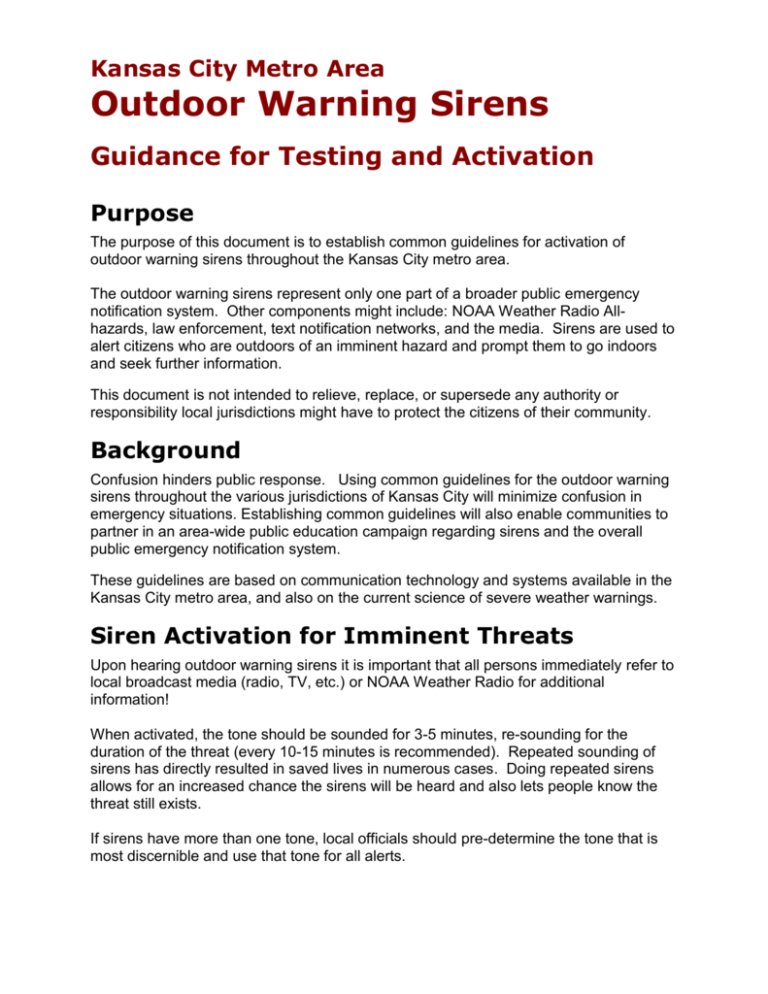
Kansas City Metro Area Outdoor Warning Sirens Guidance for Testing and Activation Purpose The purpose of this document is to establish common guidelines for activation of outdoor warning sirens throughout the Kansas City metro area. The outdoor warning sirens represent only one part of a broader public emergency notification system. Other components might include: NOAA Weather Radio Allhazards, law enforcement, text notification networks, and the media. Sirens are used to alert citizens who are outdoors of an imminent hazard and prompt them to go indoors and seek further information. This document is not intended to relieve, replace, or supersede any authority or responsibility local jurisdictions might have to protect the citizens of their community. Background Confusion hinders public response. Using common guidelines for the outdoor warning sirens throughout the various jurisdictions of Kansas City will minimize confusion in emergency situations. Establishing common guidelines will also enable communities to partner in an area-wide public education campaign regarding sirens and the overall public emergency notification system. These guidelines are based on communication technology and systems available in the Kansas City metro area, and also on the current science of severe weather warnings. Siren Activation for Imminent Threats Upon hearing outdoor warning sirens it is important that all persons immediately refer to local broadcast media (radio, TV, etc.) or NOAA Weather Radio for additional information! When activated, the tone should be sounded for 3-5 minutes, re-sounding for the duration of the threat (every 10-15 minutes is recommended). Repeated sounding of sirens has directly resulted in saved lives in numerous cases. Doing repeated sirens allows for an increased chance the sirens will be heard and also lets people know the threat still exists. If sirens have more than one tone, local officials should pre-determine the tone that is most discernible and use that tone for all alerts. Severe Weather National Weather Service warnings define the area threatened by the storm and include information about the history and/or potential of the specific storm. In addition, trained spotters provide real-time reports of an imminent threat approaching or occurring in the community. When a warning includes the specific hazards defined below or when trained spotters report any of these hazards, sirens should be activated for all jurisdictions in the threatened area. Tornadoes – Activation recommended for: Tornado Warning issued by the National Weather Service or Tornado or funnel cloud reported by a trained spotter Severe Thunderstorms – Activation recommended for: Severe Thunderstorm Warning issued by the National Weather Service or a report from a trained spotter that includes: wind 70 mph* or greater * Most fatalities during tornadoes or severe thunderstorms occur due to falling trees or large branches, or other wind driven debris. 70 mph is the typical threshold at which large branches and small trees break. (Additional background for this threshold is available in the engineering document for the Enhanced Fujita damage scale: www.spc.ncep.noaa.gov/efscale) Additional considerations: Although other weather factors pose a risk, community-wide outdoor warning sirens should NOT be sounded for lightning or flash floods. By its nature, lightning is “selfalerting” and citizens should go indoors when thunder is heard. Also, because of the frequency of lightning, sounding sirens could desensitize the public to the sirens. Although flash floods present a threat, that threat is localized and typically in a known area. In addition, Flash Flood Warnings are often issued more than one hour before the flooding occurs, allowing local officials time for mitigation efforts, and eliminating the usefulness of community-wide sirens in this situation. Local Life-threatening Events__________________________________ Non-weather emergencies (hazmat incident, terrorism, nuclear emergency, etc.) that pose a threat to those outdoors and require action to protect life, should be alerted via the outdoor warning sirens by local officials based on existing agreements or local discretion depending on the emergency. If outdoor warning sirens are activated, the life-threatening conditions should also be relayed to Pleasant Hill NWS for broadcast on NOAA Weather Radio All-hazards. All Clear There will be no “all clear” signal from outdoor warning sirens. Citizens are expected to be indoors and should monitor local media for additional information. Testing Outdoor warning sirens should be tested the first Wednesday of each month at 11:00 a.m. in conjunction with the routine weekly test (RWT) conducted by the National Weather Service. This test may be postponed or canceled based on the current or forecast weather for the day. Some municipalities may opt out of this suggested time period due to other local factors. For instance, Raymore is a bedroom community and prefers to test its siren system on Saturday’s when a higher percentage of residents are home or in the community. Kansas City Metro Area Outdoor Warning Sirens Quick Reference Guide for Activation and Testing Sirens should be sounded for 3-5 minutes, resounding for the duration of the threat (every 10-15 minutes is recommended). Severe Weather Tornadoes Tornado Warning issued by the National Weather Service and/or Tornado or funnel cloud reported by a trained spotter Severe Thunderstorms Severe Thunderstorm Warning issued by the National Weather Service or report received from a trained spotter that includes: wind 70 mph or greater Local Life-threatening Events Non-weather emergencies (hazmat incident, terrorism, nuclear emergency, etc.) that pose a threat to those outdoors and require action to protect life, should be alerted via the outdoor warning sirens by local officials based on existing agreements or local discretion depending on the emergency. All Clear There will be no “all clear” signal from outdoor warning sirens. Testing First Wednesday of each month at 11:00 a.m. If adverse weather is occurring or forecast for the Kansas City metro area on a scheduled test day, the sirens should not be tested that day. Outdoor warning siren tests will resume on the next scheduled monthly date. For various reasons, a few communities will test their sirens on days other than the standard test day. See preparemetrokc.org for a complete list of siren test times by community.
